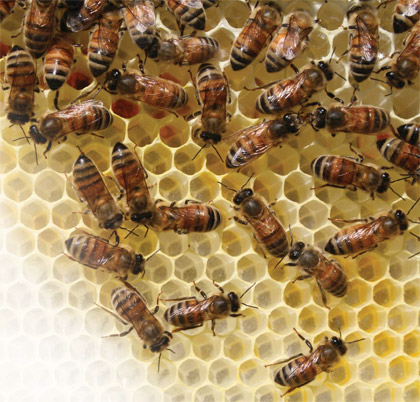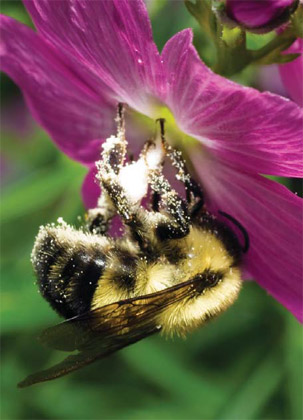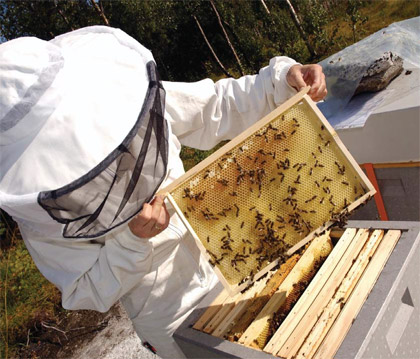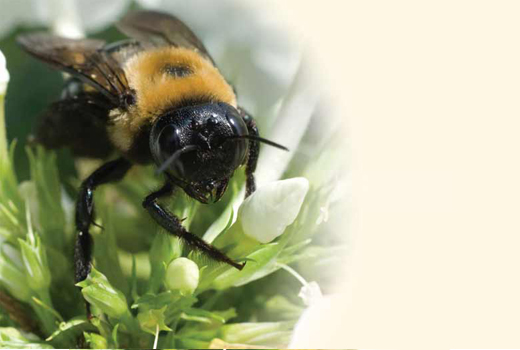Global Warming, Pollution and Bees What’s the Buzz?
When birds, bees, bats and, to a lesser degree, moths and butterflies disappear, so, too, will flowers, trees, vegetables, fruits and forage for livestock. Pollinators are critical for preserving healthy ecosystems, agricultural crops and vegetable gardens. Indeed, worldwide approximately 80 percent of plants grown for food, beverages (including chocolate and coffee) and medicine need pollinators to transfer pollen between flowers for successful seed and fruit production. Even cotton needs pollination. Honey bees, the most important of these pollinators, are “responsible for $15 billion in added crop value. About one mouthful in three in the diet directly or indirectly benefits from honey bee pollination,” explains the United States Department of Agriculture (USDA).
In October 2006 beekeepers started noticing a significant loss in their honey bee hives – up to 60 percent. In fact, managed honey bee colonies have dropped from 5 million in the 1940s to less than 2.5 million today, according to the USDA. In addition, honey bee health has been steadily declining because of unknown causes such as Colony Collapse Disorder (CCD) and known causes such as new pathogens and pests, new stresses and pesticides.
“Despite its apparent lack of marquee appeal, a decline in pollinator populations is one form of global change that actually has credible potential to alter the shape and structure of terrestrial ecosystems,” stated May R. Berenbaum, Ph.D., professor and head of the entomology department at University of Illinois, Urbana-Champaign, in a 2006 National Academy of Sciences’ report Status of Pollinators in North America. Berenbaum’s research on chemical interactions between insects and the plants they pollinate makes her uniquely qualified to consider pesticide effects on honey bees. “It’s a double-edged sword. From a grower’s perspective, it’s hard to imagine achieving the level of productivity we have achieved without some way to assist plants in fending off their enemies even if you grow organically. The problem we have is prophylactic use; people tend to use a chemical before there’s really a need . . . the American idea that if a little is good, then more is better,” says Berenbaum.
Chemical misuse is just one of the stressors causing pollinator disappearance. Another is global climate change. “Global climate change appears to be contributing to a mismatch between pollinators and plants. European data shows there have been shifts in distribution of pollinators, especially bumble bees. And the plants that depend upon them are also undergoing shifts,” says Berenbaum.
Changes in Bee Behavior
Evidence suggests that global warming is to blame for modifying plant and animal ranges in the past few decades; that, in turn, is altering migration travel patterns. Migratory pollinators journey along routes where flowers bloom at the appropriate time during their migrations. If the timing doesn’t coincide, plants could suffer less pollination while travelers could face a long flight with no opportunity to replenish their energy along the way. In addition, increased carbon dioxide may change the production of nectar, the sweet liquid secreted by flowers and gathered by bees for making honey. And these alterations in nectar production can affect foraging pollinator behavior. Another contributing factor is increasing ultraviolet-B radiation caused by ozone depletion, which can delay flowering or reduce flowering production altogether (thus impacting plant and pollinator reproductive success).

© iStockphoto.com/merrymoonmary
Wayne Esaias, a NASA scientist and a master beekeeper in Maryland, is conducting research that concurs with these findings. He’s currently working with beekeepers across the country to measure bee colony health. Collaborative research shows that plants bloom earlier as temperatures are affected by climate change. In addition, peak nectar flows are coming earlier in the year as it gets warmer – 25 days earlier as compared to 1970.
According to Esaias, “Nectar flow here in Maryland is very abundant but only for about six weeks. So, by using our honey bees to tell when those nectar flows come, we’re providing valuable information on when food is available for our native pollinators. That information would be difficult to know any other way. Neither drought nor rain nor climate kills bees directly. But all do add stress to the colony. Last year was a very wet year associated with La Niña. The plants felt that, and the pollinators had to adjust for those variabilities. When it rains, many pollinators can’t go out; rain washes nectar from the flowers so bees sometimes miss the big pollinations. Fortunately, there are small compensators, such as white clover, that produce more nectar during rainy years.”
Maryland’s temperature change, and possibly Virginia’s, is 3-4 degrees higher because of the rise associated with climate change and urban sprawl. Esaias recommends looking at the ecosystem “and the timing in which plants bloom in order to understand changes taking place. That will help us to see how drastic things may become in another 3-6 degrees. However, in some urban areas many pollinators seem to do okay when there are enough trees and principal plants to provide nectar.”
Dr. Berenbaum says other stressors to track are “the diseases that affect unmanaged wild honey bees, and those are almost assuredly a product of trade globalization. The more international and globalized trade becomes, the higher the risk of accidental importation of new pests and parasites.”
Colony Collapse Disorder
Diana Cox-Foster, Ph.D. and a Pennsylvania State University researcher, is interested in bees’ co-evolution with pathogens and parasites and the role their immune system plays within this interaction. Amazingly, her research shows that the few insects left alive in a CCD colony have almost every known pathogen found in bees. The one common denominator across all collapsed colonies is the Israeli Acute Paralysis Virus (IAPV). Researchers seem to have found a link between IAPV and three other pathogens. However, more work is needed to understand if these pathogens are merely indicators or the cause of the disorder.
“Since we published this information a year ago, our work suggests IAPV is a highly virulent virus. When bees are stressed, this disease will lead to death. Our research has also looked at how many IAPV lineages are in the United States. At least two of the three lineages have been found so far,” explains Cox-Foster.
Although viruses can obliterate a colony, more studies are necessary to ascertain what’s destroying the bees’ immune systems and predisposing them to these viruses. Experts are looking into other pathogens and pesticides and asking what effects they might have on the bees’ immune systems and what stressors may activate these pathogens. On a positive note, Pennsylvania State University shows some bees are developing an IAPV resistance as well as a Varroa mite resistance. The latter is an external parasite that feeds on developing and adult bees while inducing the spread of viruses that, if left unchecked, can kill a hive in 12 months.

© iStockphoto.com/dragon_fang
Dennis van Engelsdorp is acting Pennsylvania State Apiarist for the Pennsylvania Department of Agriculture as well as the Apiary Inspectors of America (AIA) president. He inspects colonies, collects samples for other research team members and performs bee autopsies to find a CCD diagnostic technique. Because the disorder is complex, researchers are looking at a combination of things that can destroy a colony. And because exposure to stress or risk factors fluctuates, several samples are needed over a period of time. For example, bees in overcrowded conditions are trucked across many states to pollinate a variety of crops. This process not only causes stress but also exposes them to pathogens and parasites.
Van Engelsdorp explains: “To address this, in 2007 we followed 250 colonies with the USDA along the East Coast and sampled them every time they moved. In June, when bees were in the blueberry fields of Maine, we discovered what we’re calling ‘entombed pollen’ – where bees have put a heavy layer of wax over the pollen, which is very unusual. We know, of the 36 percent of colonies that had this condition, 40 percent were dead by November, compared to 20 percent in the other group.
“For two years in a row, we’ve sustained a substantial loss of one out of every three bees, which is an astonishing number. Imagine if one out of every three cows or one out of every three chickens were dying. That would raise a lot of alarm. CCD is affecting a minority of the country’s operators so there are other stress factors that are plaguing bees. One of those is Nosema ceranae, a fungus that affects the stomach of bees. Relatively new, this fungus produces at high levels during certain times of the year and, no doubt, is causing some of the problems and mortalities affecting beekeepers. We’re looking at each of these challenges on an individual basis in order to prioritize how we address those concerns. We’ve found detections of pesticides in pollen and wax that probably aren’t good for bees, but there’s no evidence that suggests one pesticide is responsible for CCD or colony health.”
According to the USDA, “Since little is known about the cause(s) of CCD right now, mitigation must be based on improving general honey bee health and habitat and countering known mortality factors by using best management practices.”
World Honey Bee Health
TCCD is not isolated to North America. In fact, overwhelming numbers of honey bee losses are being felt worldwide. In 2007 in Taiwan, entomology professors say the effects of climate change could be seen clearly after bee farmers there reported heavy losses following hazardous weather conditions. And in the United Kingdom (UK), according to the first-ever survey of UK beekeepers, one in three hives failed to make it through 2008. Australia is working to protect its honey bees from foreign invaders since learning the varroa mite was found nearby in bees in Papua New Guinea and New Zealand. To combat this, Australia is setting up hives at certain ports where authorities are monitoring for disease and pests.
Fraser Valley, Canada, which produces one-fifth of the world’s blueberries, had to import honey bees in spring 2007 to meet pollination demands. Like many other commercial food industries, the Fraser Valley bee industry is shrinking while crop demand is increasing. According to the Canadian Association of Professional Apiculturists (CAPA), spring 2008 losses in Canada’s commercial beekeeping operations were nearly twice that of long-term trends. And last spring in British Columbia not all blueberry pollination contracts were fulfilled. Declines of commercially managed hives in the United States also are rising and reached 36.1 percent, according to an AIA survey released in May 2008.

© iStockphoto.com/sajets
In 2004 Europe began the Assessing Large-Scale Risks for Biodiversity with Tested Methods project (ALARM). The monitoring plan, an extensive and innovative European Union (EU) scientific program for long-term pollinator monitoring, began within the multi-country framework of conservation farming practices, which is reproducible in North America. According to Status of Pollinators in North America, from 2004 to 2009, 16.7 million euros were budgeted for the project. ALARM aims to quantify the environmental risks to biodiversity, including those to pollinators, with standardized and repeatable sampling methodologies. Five modules focus on pollinator loss, climate change, invasive species, environmental chemicals and socio-economics. Recent Netherlands and UK collaborations within this project show that the quantity of pollinators and insect-pollinator plants are declining in comparable numbers. Science shows that when biodiversity is lost from an ecosystem, the natural balance and normal function of ecological services are disrupted, oftentimes drastically.
Relief may be forthcoming for the United States, thanks to the Congressionally enacted Food, Conservation and Energy Act of 2008. Commonly known as “The Farm Bill,” it’s the first legislation of its kind to enact pollinator provisions to protect and to enhance habitat and health. Interestingly enough, the United States once banned honey bee importation to protect U.S. bees from exotic pests, parasites, pathogens and predators via the 1922 Federal Honey Bee Act. However, in 2004 the United States revised these importation regulations to allow queens, attendant worker bees and bee packages to be imported from Australia, Canada and New Zealand.
What To Do
Farmers everywhere are aware of honey bees’ importance. For instance, 700,000 almond crop acres in California alone rely on managed honey bees for pollination. Many other fruit and vegetable growers feel they’ll be forced to leave the business if they are unable to rent the bees needed to pollinate their crops.
Because no apparent single cause of CCD exists, researchers are no closer to a solution. Hopefully, with the passage of future federal legislation, such as the Pollinator Habitat Protection Act, pollinators will be better sheltered. In the meantime, to help the situation, experts suggest planting and encouraging more planting of good nectar sources, such as red clover, foxglove, bee balm and joe pye weed. This will help feed the honey bees because they may be suffering from poor nutrition. More simply, they may not have enough plants or high-quality plants within their range to forage on.
In addition, consumers need to be more responsible with pesticide use. Don’t use pesticides indiscriminately, especially in the middle of the day when bees are out foraging for nectar. Some researchers believe pesticides impair honey bee memory and communications plus cause obvious adverse health implications. Fresh water is also important. This can be a birdbath, pond or other source of dripping water that creates a damp spot on the ground that bees can access. Visiting pollinator sites and donating funds to state beekeepers’ associations will also help protect and monitor local bee populations. Supporting local beekeepers is extremely important for bee health; their efforts to maintain records will assist scientists.
“Let me tell you about the birds and the bees and the flowers and the trees . . . .” The loss felt by pollinator and plant declines will be devastating to plant and animal ecosystems worldwide. As a result, animal and plant-based foods will be severely impacted. Not only will food prices increase, but availability will decrease drastically (thus creating an increased global food shortage). Life on Earth will alter in ways unimaginable.
“Bees are irreplaceable. Their loss will be catastrophic,” laments Dr. George McGavin of the Oxford University Museum of Natural History. Indeed, even Albert Einstein is quoted as saying that if bees disappear, humans will have only 4 years to live. Although many believe the Einstein quote was invented, do we really want to test the theory? Bee friendly. Support pollinators by supporting their habitats. A life without bees would be a life unimaginable by anyone’s standards





























